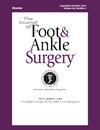Iatrogenic medial malleolar fracture and stress fracture considerations in total ankle joint replacement: A multicenter retrospective study
IF 1.3
4区 医学
Q2 Medicine
引用次数: 0
Abstract
Total ankle replacement (TAR) is a challenging but rewarding treatment option for primary or post-traumatic tibiotalar osteoarthritis. Acute and latent postoperative stress fractures of the medial malleolus, however, pose a common potential complication that may arise during joint resection, especially during implantation of the tibial component. This is a multicenter retrospective study highlighting considerations for iatrogenic medial malleolar fractures during and after TAR surgery by assessing relationships between fractures and medial malleolus width (MMW). 159 patients undergoing primary TARs without prophylactic tibial fixation from 2016-2022 were selected from multiple institutions. MMW (mm) was measured as the distance between the tibial tray component placement and the medial malleolus’ outer cortex using standard AP ankle radiographs intraoperatively and postoperatively. Demographics included BMI, gender, age, and implant type. Average MMW of the 148 patients without fracture was 11.12 mm. Average MMW was 9.43 mm in the 11 patients who suffered intraoperative medial malleolus fracture (n = 7) or developed postoperative stress fracture (n = 4). Tibial fixation was performed only in the fracture group. The difference in MMW between the two groups was statistically significant (p < 0.05). There were no statistically significant differences among all the demographics. Mean follow-up, age, and BMI were 20.9 months, 64.4 years, and 30.4, respectively, and there were no statistically significant differences among demographics. This data demonstrates how shorter MMW, specifically a threshold of 9.43 mm or shorter, may be associated with higher probability of intraoperative or postoperative stress fracture of the medial malleolus.
全踝关节置换术中医源性内踝骨折和应力性骨折:一项多中心回顾性研究。
对于原发性或创伤后胫跖骨关节炎,全踝关节置换术是一种具有挑战性但有益的治疗选择。然而,内踝的急性和潜伏性术后应力性骨折在关节切除术中,特别是在胫骨植入过程中,可能会引起常见的潜在并发症。这是一项多中心回顾性研究,通过评估骨折与内踝宽度(MMW)之间的关系,强调了在TAR手术期间和之后医源性内踝骨折的注意事项。2016-2022年,来自多个机构的159例未进行预防性胫骨固定的初级TARs患者。MMW (mm)为胫骨托盘植入物与内踝外皮层之间的距离,采用标准AP踝关节x线片进行术中及术后测量。人口统计包括BMI、性别、年龄和植入物类型。148例无骨折患者平均MMW为11.12 mm。术中内踝骨折(n = 7)或术后发生应力性骨折(n = 4)的11例患者MMW平均为9.43 mm。仅骨折组进行胫骨固定。两组患者MMW差异有统计学意义(p < 0.05)。在所有的人口统计数据中没有统计学上的显著差异。平均随访时间为20.9个月,平均年龄为64.4岁,平均BMI为30.4岁,人口统计学差异无统计学意义。该数据表明MMW较短,特别是阈值为9.43 mm或更短,可能与内踝术中或术后应力性骨折的较高概率相关。
本文章由计算机程序翻译,如有差异,请以英文原文为准。
求助全文
约1分钟内获得全文
求助全文
来源期刊

Journal of Foot & Ankle Surgery
ORTHOPEDICS-SURGERY
CiteScore
2.30
自引率
7.70%
发文量
234
审稿时长
29.8 weeks
期刊介绍:
The Journal of Foot & Ankle Surgery is the leading source for original, clinically-focused articles on the surgical and medical management of the foot and ankle. Each bi-monthly, peer-reviewed issue addresses relevant topics to the profession, such as: adult reconstruction of the forefoot; adult reconstruction of the hindfoot and ankle; diabetes; medicine/rheumatology; pediatrics; research; sports medicine; trauma; and tumors.
 求助内容:
求助内容: 应助结果提醒方式:
应助结果提醒方式:


